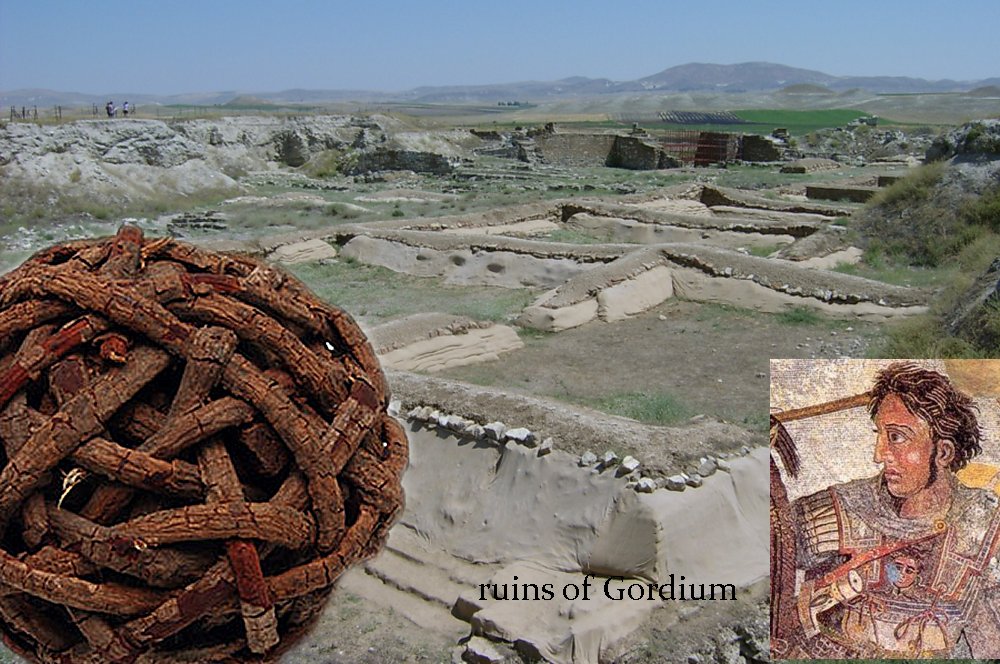Gordian Knot And How Alexander The Great Managed To Outmaneuver The Problem
A. Sutherland - AncientPages.com - The Gordian Knot is a metaphorical expression that means a complicated problem or deadlock when we have an unsolvable problem, which is our "impossible knot."
Alexander the Great slicing the Gordion knot with a sword-stroke. Credit: Public Domain
It began long ago when the Phrygians had no ruler and plunged into a civil war. An ancient prophecy of the oracle was announced at Telmissus (the ancient capital of Lycia).
It said that the new king would be the one who would enter the city in a simple ox-cart.
The first through the city's gates were Gordias, a poor peasant who came to the town with a cart drawn by an ox with his wife. He tied its yoke to a post with a highly sophisticated knot called the Gordian Knot. Gordias was declared king, and his grateful son, Midas, dedicated the ox-cart to the Phrygian god Sabazios (identified with Zeus).
Roman historian Quintus Curtius Rufus later described the knot as a masterwork. It comprised "several knots all so tightly entangled that it was impossible to see how they were fastened."
Gordias founded the city of Gordium, which became the Phrygian capital, and his ox-cart was preserved and remained in the royal palace. According to the oracle's prophecy, a man who untied the knot would receive power over Asia Minor or all of Asia.
In the 4th century BC, Alexander the Great reached Phrygia and Gordium, allegedly Midas's capital. After taking the city of Gordium, Alexander was shown the chariot of Gordias, founder of the old Phrygian monarchy, and was told about the prophecy.
Alexander wanted to untie the knot, but he had no idea how to do it, so he drew his sword and sliced it in half with a single stroke, or as another version says, he loosed the knot by pulling the linchpin from the yoke.
Aristobulus, an early historian, architect, and military engineer, as well as a close friend of Alexander) later claimed that untying the knot was easy for Alexander; he removed what they call the pole-pin, with which the yoke-knot was held together, and then drew back the yoke.
We will never know what really happened in the palace in Gordium and whether Alexander managed to untie the complex knot.
Norman F. Cantor, in his book "Alexander the Great Journey to the End of the Earth" writes:
"Shortly after one of Alexander's first victories, the Battle of Granicus, he learned that a few miles away, a certain King Gordias had left as a legacy a very difficult knot to untie. It was said (probably by Alexander's propagandists) that whoever untied the knot would conquer all of Asia. Sources disagree about what happened.
Some say that Alexander cleverly untied the knot, others that he simply unsheathed his sword and cut it. But one way or another, he untied or "cut the Gordian knot."
Fox relates the tale this way:" On the day before leaving Gordium, he went up to the acropolis meaning to try the chariot which he had saved for his farewell; friends gathered round to watch him, but hard though he pulled, the knot round the yoke remained stubbornly tight. When no end could be found, Alexander began to lose patience, for failure would not go down well with his men. Drawing his sword, he slashed the knot in half, producing the necessary end and correctly claiming that the knot was loosed, if not untied. The aged Aristobulus (one of Alexander's early historians)… later claimed that Alexander had pulled a pin out of the chariot link and drawn the yoke out sideways through the knot, but the sword cut has the weight of authority behind it and is preferable to an eighty-year-old historian's apology; either way, Alexander outmaneuvered, rather than unraveled, his problem.
He also managed to arouse an interest in what he had done."
"There were thunderclaps and flashes of lightning that very night," conveniently signifying that Zeus approved, so Alexander offered sacrifice to the "gods who had sent the signs and ratified his loosing of the knot..." (Robin Lane Fox, Alexander the Great)
Tough, resolute, fearless. Alexander was a born warrior and a ruler of passionate ambition who understood the intense adventure of conquest and of the unknown. When he died in 323 B.C.E. at age thirty-two, his vast empire comprised more than two million square miles, spanning from Greece to India. His achievements were unparalleled—he had excelled as a leader to his men, founded eighteen new cities, and stamped the face of Greek culture on the ancient East. The myth he created is as potent today as it was in the ancient world. Robin Lane Fox's superb account searches through the mass of conflicting evidence and legend to focus on Alexander as a man of his own time. Combining historical scholarship and acute psychological insight, it brings this colossal figure vividly to life.." Read more
Alexander later went on to conquer Asia as far as the Indus and the regions of the Oxus, a major river in Central Asia. The prophecy was fulfilled.
Written by – A. Sutherland AncientPages.com Staff Writer
First version of this article was published on July 20, 2020
Copyright © AncientPages.com All rights reserved. This material may not be published, broadcast, rewritten or redistributed in whole or part without the express written permission of AncientPages.com
More From Ancient Pages
-
 Rare Bronze Age Sacrificial Offerings, Including A Bent Sword Found In A Bog Near Veksø, Denmark
Archaeology | Dec 3, 2024
Rare Bronze Age Sacrificial Offerings, Including A Bent Sword Found In A Bog Near Veksø, Denmark
Archaeology | Dec 3, 2024 -
 Amaru (Katari) – Powerful Inca God Who Controlled Weather Phenomena
Featured Stories | Apr 9, 2024
Amaru (Katari) – Powerful Inca God Who Controlled Weather Phenomena
Featured Stories | Apr 9, 2024 -
 Ancients Built Hindu Temples On A Straight Line Without Access To Satellite Images
Archaeology | Feb 24, 2017
Ancients Built Hindu Temples On A Straight Line Without Access To Satellite Images
Archaeology | Feb 24, 2017 -
 Roman-era mass grave with 60 bodies found in farmer’s field
Civilizations | Aug 27, 2015
Roman-era mass grave with 60 bodies found in farmer’s field
Civilizations | Aug 27, 2015 -
 Mysterious Medieval Cemetery In Wales With People Buried In Unusual Positions Puzzles Archaeologists
Archaeology | Jan 3, 2024
Mysterious Medieval Cemetery In Wales With People Buried In Unusual Positions Puzzles Archaeologists
Archaeology | Jan 3, 2024 -
 Unexplained Historical Sighting And Archaeological Discovery Reported In Alberta By Police Officer
Featured Stories | Jul 1, 2024
Unexplained Historical Sighting And Archaeological Discovery Reported In Alberta By Police Officer
Featured Stories | Jul 1, 2024 -
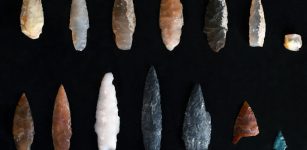 Oldest Known Projectile Points In The Americas Discovered In Idaho
Archaeology | Dec 23, 2022
Oldest Known Projectile Points In The Americas Discovered In Idaho
Archaeology | Dec 23, 2022 -
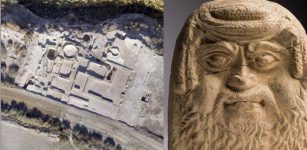 Huge Roman Forum Discovered In Unknown Ancient City In Spain
Archaeology | Sep 4, 2023
Huge Roman Forum Discovered In Unknown Ancient City In Spain
Archaeology | Sep 4, 2023 -
 Controversial Roman Emperor Heliogabalus Wanted To Be A Woman And Much More
Featured Stories | Jun 14, 2020
Controversial Roman Emperor Heliogabalus Wanted To Be A Woman And Much More
Featured Stories | Jun 14, 2020 -
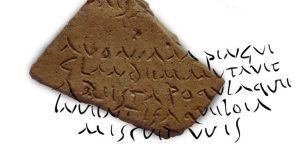 Incredible Discovery Of A Poem By Virgil On A Roman Oil Amphora
Archaeology | Jun 21, 2023
Incredible Discovery Of A Poem By Virgil On A Roman Oil Amphora
Archaeology | Jun 21, 2023 -
 Copper Artifacts Reveal Changing Connections In Prehistoric Europe
Archaeology | May 11, 2023
Copper Artifacts Reveal Changing Connections In Prehistoric Europe
Archaeology | May 11, 2023 -
 Peculiar Unsolved Greek Mystery In New York
Featured Stories | Mar 26, 2024
Peculiar Unsolved Greek Mystery In New York
Featured Stories | Mar 26, 2024 -
 Norse Goddess Sif Who Lost Her Golden Hair Due To Loki’s Evil Deed
Featured Stories | Jun 30, 2018
Norse Goddess Sif Who Lost Her Golden Hair Due To Loki’s Evil Deed
Featured Stories | Jun 30, 2018 -
 Newly Described Species Of Dome-Headed Dinosaur May Have Sported Bristly Headgear
News | May 24, 2023
Newly Described Species Of Dome-Headed Dinosaur May Have Sported Bristly Headgear
News | May 24, 2023 -
 Never Explained Mystery Of Star-Shaped Towers Of The Himalayas
Ancient Mysteries | Nov 24, 2014
Never Explained Mystery Of Star-Shaped Towers Of The Himalayas
Ancient Mysteries | Nov 24, 2014 -
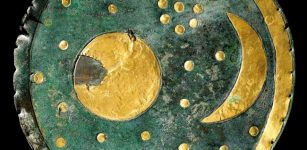 Nebra Disc – Artifact That Represents 3,600-Year-Old Astronomical Knowledge
Artifacts | May 26, 2014
Nebra Disc – Artifact That Represents 3,600-Year-Old Astronomical Knowledge
Artifacts | May 26, 2014 -
 Stone Age Humans Unlocked The Glucose In Plants 40,000 Years Ago
Archaeology | Apr 1, 2020
Stone Age Humans Unlocked The Glucose In Plants 40,000 Years Ago
Archaeology | Apr 1, 2020 -
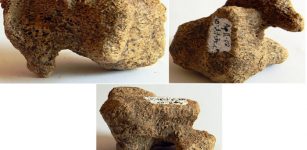 12,000 Years Ago Siberian People Possessed Technique To Soften Ivory And Create Toys Or Art Items
Ancient Technology | Jan 6, 2021
12,000 Years Ago Siberian People Possessed Technique To Soften Ivory And Create Toys Or Art Items
Ancient Technology | Jan 6, 2021 -
 Mysterious 70-Million-Year-Old Underground Village And Magnificent Tower Of Eben-Ezer In Belgium
Featured Stories | Mar 20, 2017
Mysterious 70-Million-Year-Old Underground Village And Magnificent Tower Of Eben-Ezer In Belgium
Featured Stories | Mar 20, 2017 -
 Giant Bath Tub Built For Tsar Alexander I – Why Was It So Large?
Featured Stories | Jul 11, 2018
Giant Bath Tub Built For Tsar Alexander I – Why Was It So Large?
Featured Stories | Jul 11, 2018


